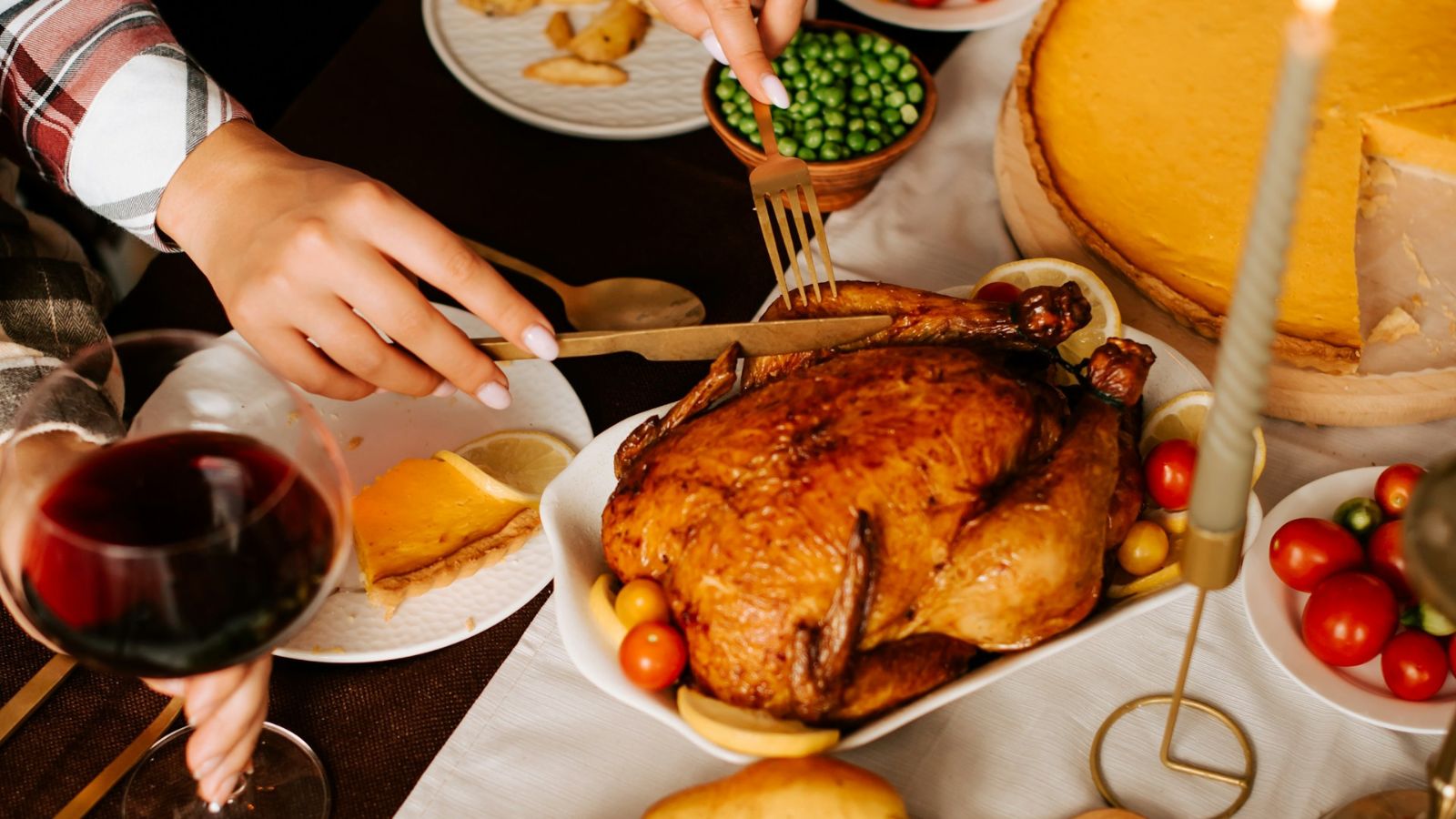Are you a Dakini or a Daka? What is the Wisdom Dakini or Heruka in Buddhism? Why is their practice important?
What is the Wisdom Dakini or Daka in Buddhism? Which one are you? A Dakini or a Daka? Why is their practice especially important in modern, active life, overcoming the obstacles and the poisons? Why are they often depicted...

 Padma (Lotus) Family Heruka and Dakini, Hayagriva and Vajravarahi. Herukas or Daka’s represent Compassionate Method Activities and Dakinis represent Wisdom Activities. Both Prajna Dakas and Prajna Dakanis are the Enlightened Activities of the Buddhas.
Padma (Lotus) Family Heruka and Dakini, Hayagriva and Vajravarahi. Herukas or Daka’s represent Compassionate Method Activities and Dakinis represent Wisdom Activities. Both Prajna Dakas and Prajna Dakanis are the Enlightened Activities of the Buddhas.
What is the Wisdom Dakini or Daka in Buddhism?
Which one are you? A Dakini or a Daka?
Why is their practice especially important in modern, active life, overcoming the obstacles and the poisons?
Why are they often depicted dancing, standing, and sometimes ferocious or even naked?
We answer these questions in this feature, with suggestions on how to define which practice is best for you, and introduce you to these Wisdom Activity practices in Buddhism.
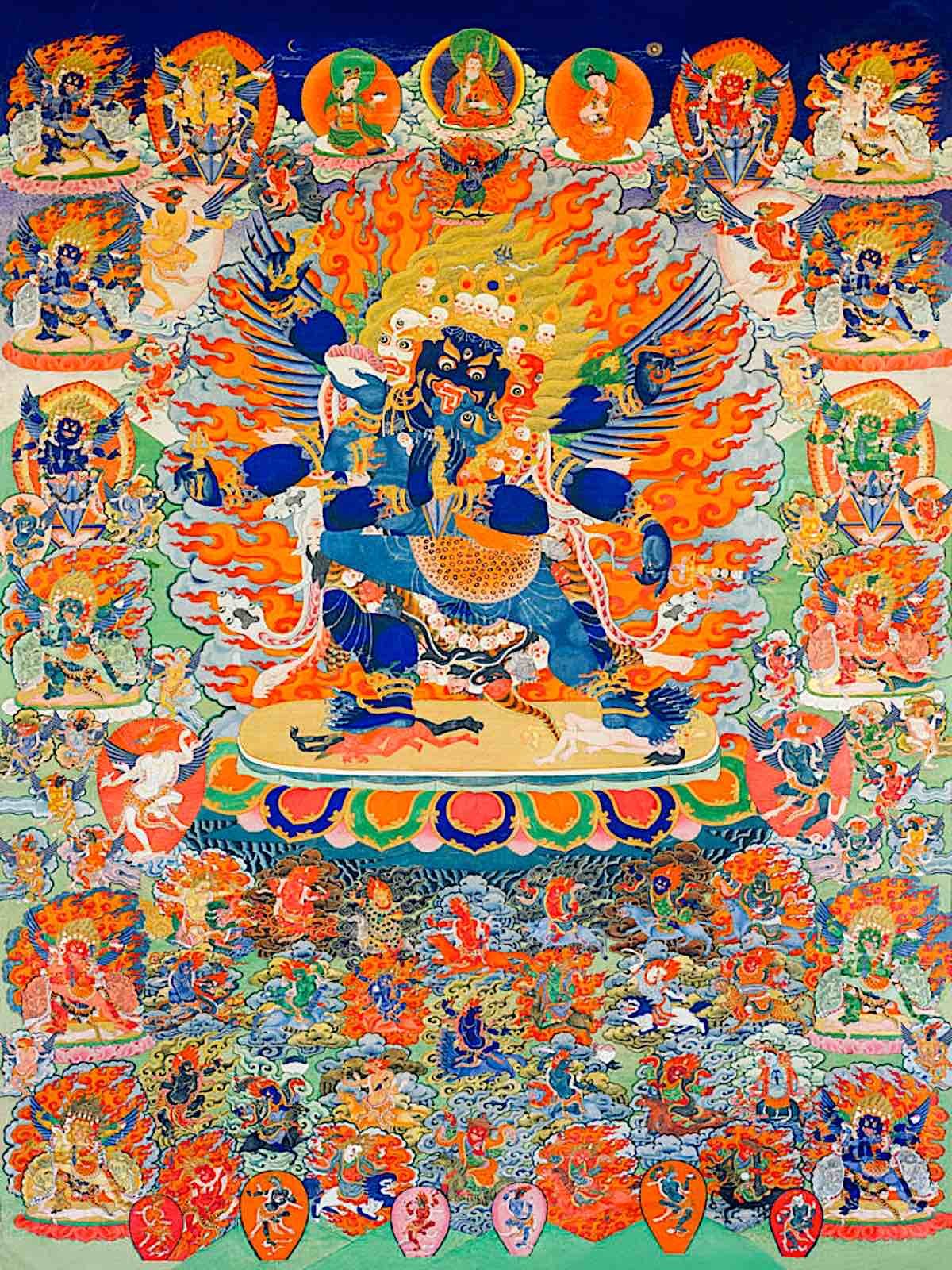 This is the typical form of Vajrakilaya (with Phurba, center), one of the 8 Great Herukas, with six arms, three faces and consort, with Heruka wings. Surrounding him in this thangka are the Five Great Herukas (with wings) and the many Dakinis and Dakas, often known as the 58 Wrathful ones.
This is the typical form of Vajrakilaya (with Phurba, center), one of the 8 Great Herukas, with six arms, three faces and consort, with Heruka wings. Surrounding him in this thangka are the Five Great Herukas (with wings) and the many Dakinis and Dakas, often known as the 58 Wrathful ones.
Most Important Practices of Vajrayana Buddhism?
In some ways, the Prajna (Wisdom) Dakini and Daka Yidam practices are the most important practices in daily Vajrayana Buddhism. They are also called Bodhi Dakinis and Herukas (“Bodhi” means awakened or enlightened, usually indicated by a third eye in the forehead.)
Why? Because daily living — and daily practice — is about activity. Activity is the domain of the Wisdom Dakini and Wisdom Daka. The shortest essence definition of Prajna Dakini or Prajna Daka is Enlightened Activity.
For this reason, we reserve every 10th of the lunar month for Prajna Daka practice, and every 25th of the lunar month for Prajna Dakini practice.
For a calendar of the 10th Daka Heruka Days and the 25th Dakini Days, see our calendar>>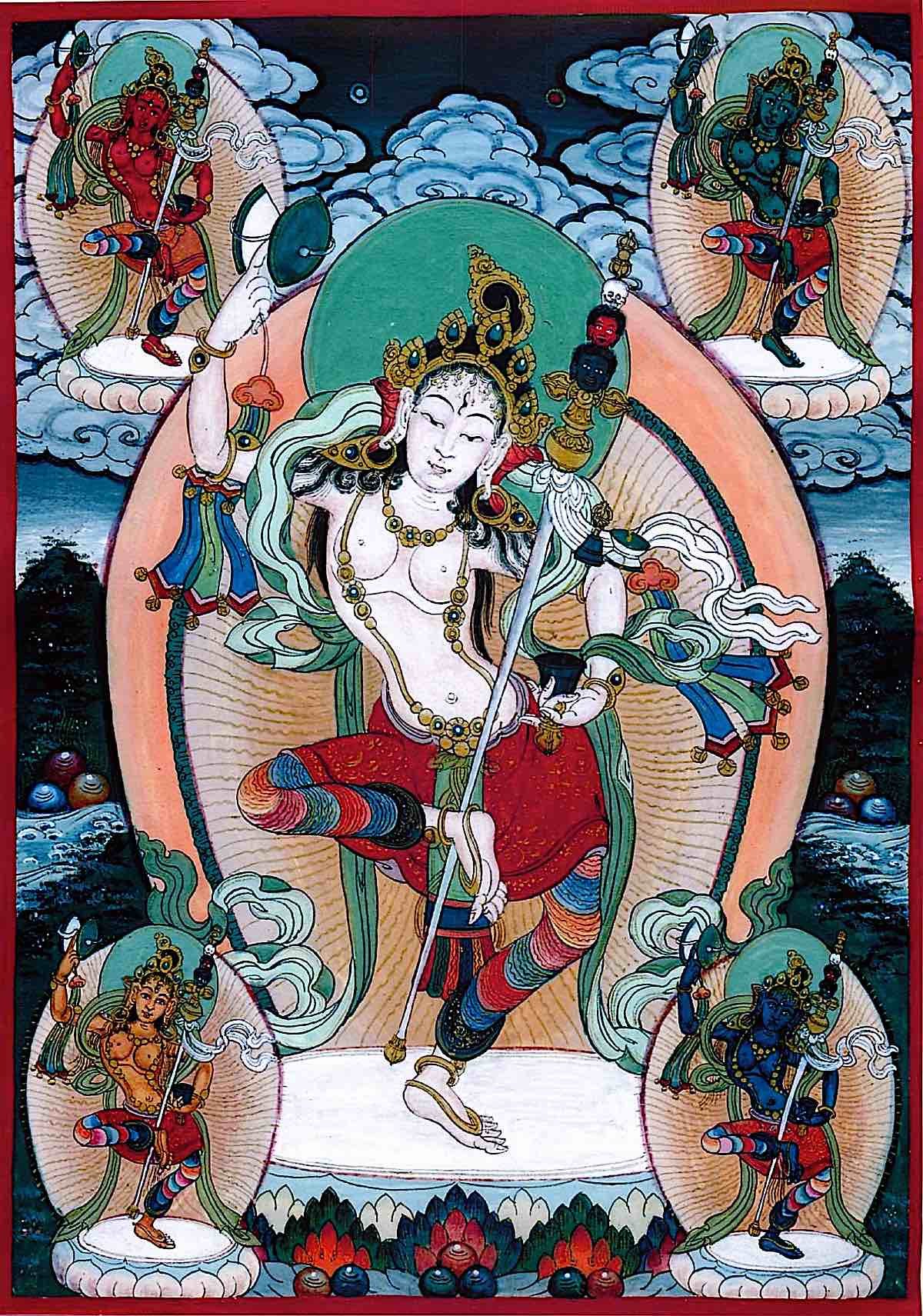 The five Wisdom Dakinis represent Wisdom activities. They are named for their families. Buddha Dakini in the center, and clockwise from top left Padma Dakini (West), Karma Dakini (North), Vajra Dakini (East), and Ratna Dakini (south)
The five Wisdom Dakinis represent Wisdom activities. They are named for their families. Buddha Dakini in the center, and clockwise from top left Padma Dakini (West), Karma Dakini (North), Vajra Dakini (East), and Ratna Dakini (south)
Wisdom Dakini or Heruka
Here, we’re referring only to Wisdom Dakini or Wisdom Daka (Prajna Daka or Dakini), or Enlightened Dakinis and Dakas, usuallyl indicated by the third eye in the forehead. The terms Daka and Dakini, without the qualifier Wisdom, is sometimes also used to mean practitioners, as in the use of yogi and yogini. In this presentation we only discuss the Dakini and Daka deities.
Dakas and Dakinis are both “activity” oriented Enlightened meditational deities, but they differ in two key ways. The Dakas focus on the activities of Compassionate Method, the Bodhisattva Path, and for this reason are also called Herukas or Heroes, or Pawo in Tibetan. The Dakinis focus on wisdom activities, and are called khandroma in Tibetan. Both Daka and Dakini are Activity.
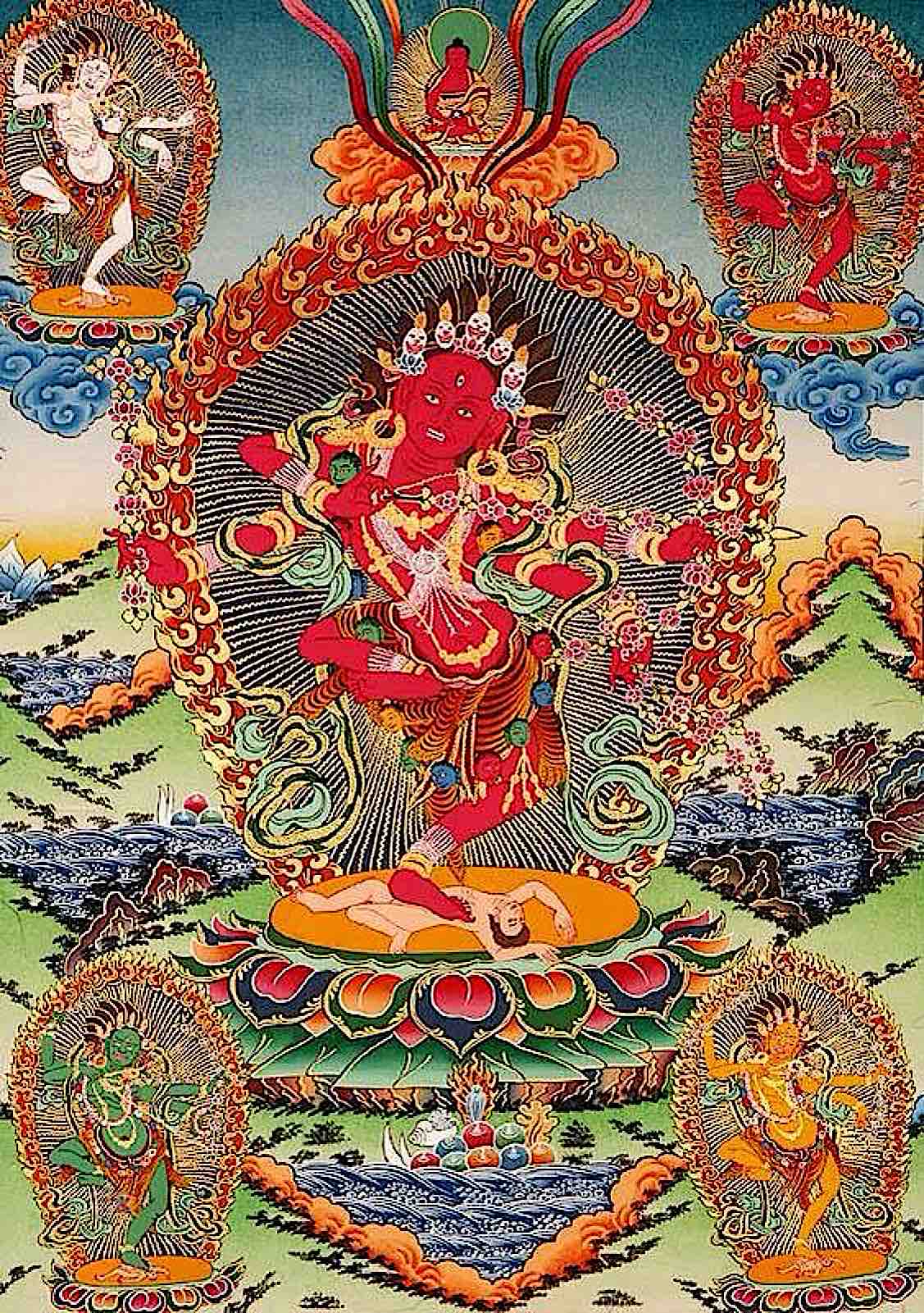 One of Kurukulla’s mandalas with five colours of Dakini.
One of Kurukulla’s mandalas with five colours of Dakini.
Which One Are You: Dakini or Heruka?
We began by asking “Which one are you?” It has less to do with gender, and more to do with which activity you’re more focused on — wisdom activities or compassionate method activities. If you focus on Wisdom activities, chances are good you are attracted to Dakini practices. If you find method and compassion practices more suitable, you might feel drawn to the Herukas or Dakas. Later, in this presentation, we’ll discuss the five families of Dakas and Dakinis, which helps your teacher, and you, find the practice most suitable for you.
These, are, as you’d expect, grouped by their Buddha family: Buddha Dakini and Buddha Heruka. Padma Dakini and Padma Heruka, Karma Dakini and Karma Heruka, Vajra Dakini and Vajra Heruka, and Ratna Dakini and Ratna Heruka. Each of these activity Dakas and Dakinis focuses on a different poison, remedy, activity, and method.
 Vajra Heruka with Dakini
Vajra Heruka with Dakini
Let’s start with: Are you a Dakini or a Daka?
You are a Daka or Heruka if…
… you are more engaged by compassionate methods, you might favor Heruka practices. These include active purification, blessings, transformation, healing, enriching, pacifying, controling and wrathful activities for the purpose of helping all sentient beings.
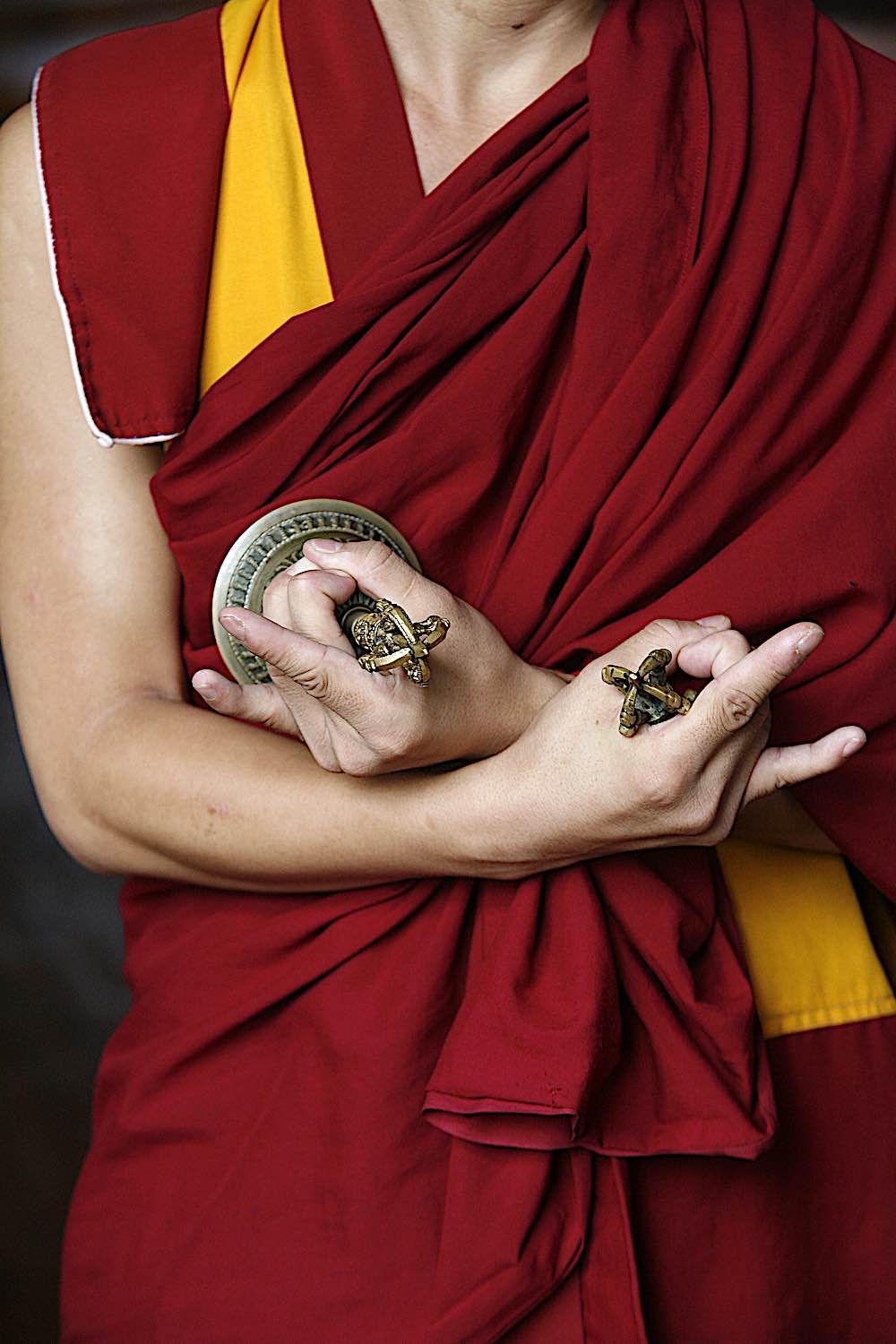 In Vajrayana, the Vajra (Dorje), here held in right hand represents Compassionate Means, and Daka or Heruka, while the Bell (Ghanta) held in the left represents Wisdom or Dakini. Holding them together in front of you represents the union of Wisdom and Method.
In Vajrayana, the Vajra (Dorje), here held in right hand represents Compassionate Means, and Daka or Heruka, while the Bell (Ghanta) held in the left represents Wisdom or Dakini. Holding them together in front of you represents the union of Wisdom and Method.
You are a Dakini if…
… you favor wisdom activity methods. Dakini practices are wisdom activity focused. These might include Dzogchen and Mahamudra meditation, Completion practices, body mandala practices, emptiness contemplation and the six Yogas of Naropa. It has nothing to do with your gender, and everything to do with your focus.
 Kurukulla, a form of Red Tara, is a Dakini and represents Controlling Wisdom Activities.
Kurukulla, a form of Red Tara, is a Dakini and represents Controlling Wisdom Activities.
Does Gender Matter?
Men can, and often do, have Dakini Yidams or meditational deities, because their practice is Wisdom-oriented. Women can, and often do, have Daka or Heruka Yidams, because they are more engaged in method.
Both are complete, because it is always understood that both Dakas and Dakinis emphasize all three of compassion, wisdom and activity. The difference is emphasis.
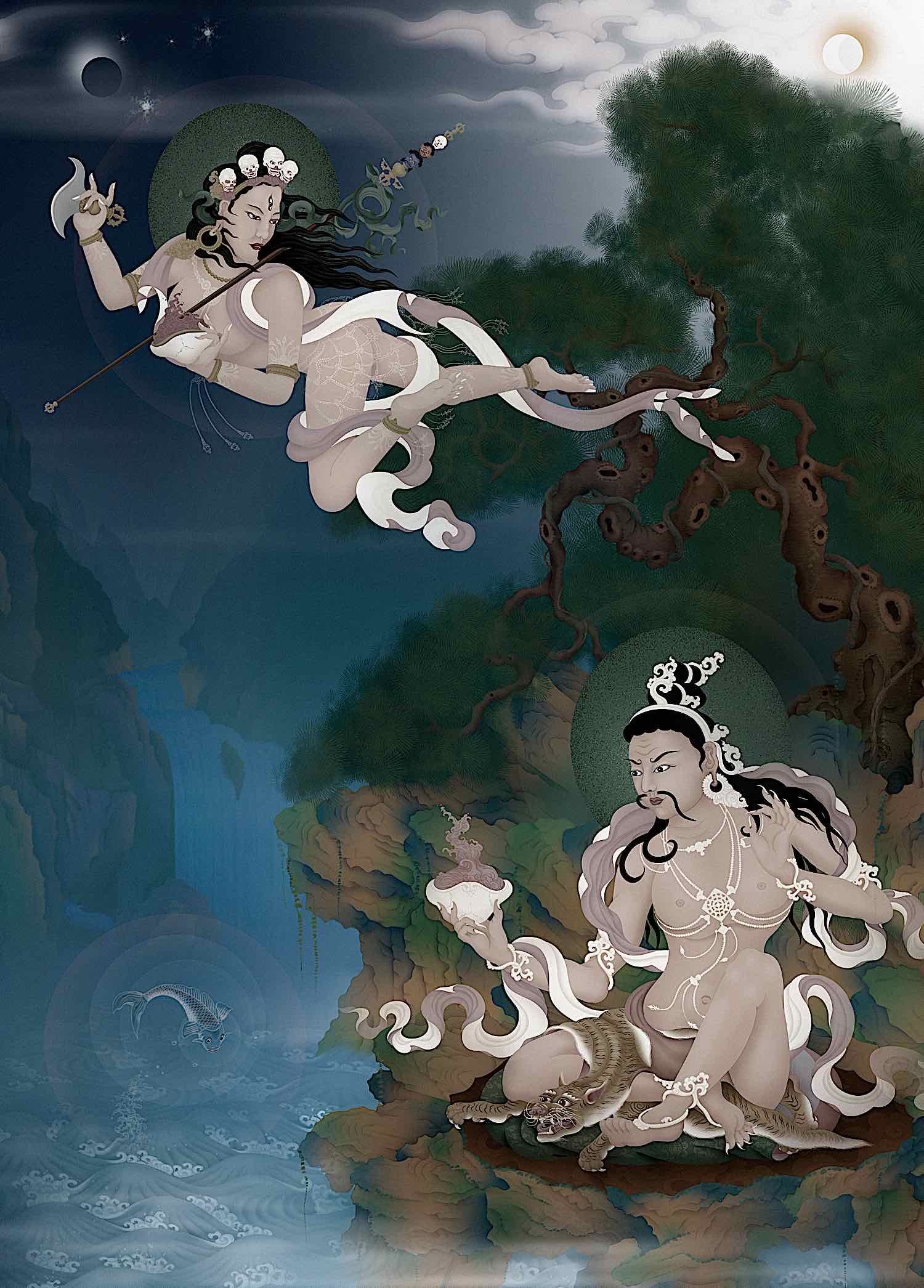 Stunning thangka detail of Tilopa visualizing a flying Dakini Enlightened deity. These great Mahasiddas and yogis reputedly could fly, walk through stone walls, and many other activities symbolic of Enlightened Mind.
Stunning thangka detail of Tilopa visualizing a flying Dakini Enlightened deity. These great Mahasiddas and yogis reputedly could fly, walk through stone walls, and many other activities symbolic of Enlightened Mind.
Standing, Flying or Ferocious Symbolism
Because of the activity symbolism, the Enlightened Dakas and Dakinis are more likely to be standing, dancing, flying, ferocious in appearance, sometimes with multiple faces, arms and legs — all symbols of their constant activity.
Dakini Wisdom deities tend to be naked, because they represent the freedom of thought without concept, of Emptiness and unencumbered and uninhibited thought.
Dakas and Herukas, as the action heroes of method tend to be more complex, carrying symbolic implements, usually with wings to symbolize they are “sky goers.”
Names of the Best Known Enlightened Dakinis
Vajrayogini Vajravārāhī Yeshe Tsogyal Nairatmya Samantabhadrī Kurukullā Machig Labdrön Mandāravā Simhamukha (Lion Faced Dakini) Niguma Ekajati or Blue TaraNames of Eight Great Herukas
Yamantaka or Vajrabhairava Hayagriva Vishuddha or Sri Samyak or Yangdak Heruka or Shri Heruka Mahottara or Mahottra or Mahashri Heruka Vajrakilaya or Vajrakumara Matarah Lokastotrapuja-natha VajramantrabhiruHayagriva’s Mantra Video: Hayagriva is one of the 8 Great Bodhisattvas and also Padma Heruka, the Hero of the Padma or Lotus Family. He is the Heruka emanation of Amitabha and Avalokiteshvara. His mantra (without empowerment, only visualize Hayagriva in front of you.):
Sky-Goers as Yidams
In Dakini terms, the sky-goer symbolism is represented by dancing, which is a metaphor for putting wisdom into meritorious action.
Dakinis and Dakas can be confusing, because the word arises from the Sanskrit. The Sanskrit term ḍakini is related to ḍiyate, meaning “to fly”. However, the actual term should be jnana dakini, which means “wisdom” Dakini or enlightened Dakini. In Tibetan language this becomes khandroma, meaning “sky-goer.”
Likewise, we’re not discussing Dakas generally, but rather wisdom Daka or Enlightened Heruka and “pawo” in Tibetan. Non-enlightened Herukas can be protectors and wisdom kings, for example, and dakini can mean worldly protectors and deities. Here, as Yidams, we only discuss the Enlightened Dakinis and Dakas, because worldly Dakas and Dakinis are never Yidams.
When a teacher gives you a Wisdom Dakini or Heruka practice — or you choose one for yourself and seek empowerment from a teacher — it’s usually because this activity is most beneficial to you right now. If you, or your teacher, recognize that attachment, clinging or lust is the poison that most impacts your daily life, and your focus is wisdom activity, then your teacher might recommend, for example, Padma Dakini or Vajrayogini, or other Red Dakini forms such as Kurukulla.
Colorful Dakas and Dakinis and Symbolism
The Dakinis, like all Vajrayana deities, are usually symbolically depicted in colors representing their activity. In actuality, a Wisdom Dakini can appear in any form, but the colors, poses and attributes represent the focus of their practice. For example, Vajravarahi is often red or blue or other colors. And, she can appear in various forms.
If you take a Wisdom Dakini as Yidam, you are bringing that activity into your practice, because you, or your teacher, recognized you needed that activity.
How do you Choose?
How do you choose your practice? Usually, if you are fortunate and have a teacher, you’ll have a recommendation. Or, through the course of foundation practices, you’ll discover the areas you need to work on most. Usually these are your strongest poison or delusion.
There are five groups of activities, which are the remedies for the five main poisons or delusions that afflict beings in Samsara. These are codified in the Five Buddha Families.
Each Buddha Family will have several Dakinis and Dakas or Herukas, but we’ll mainly highlight the Heruka aspect of the Buddha of the family, or the Dakini aspect of the Wisdom Mother of the family.
In other presentations, throughout this website, we cover some of these Herukas and Dakinis individually. For now, the question is, Daka or Dakini? Method or Wisdom? Once you know that, which activity and family is most beneficial to you now. This is why we have teachers, to guide us, and then instruct us appropriately. But here is a quick overview, which can vary by lineage or tradition.
White Buddha Family Dakinis and Dakas
The White Buddha Family of Vairochana and Dhatvishvara overcomes the obstacles of Delusion and Ignorance with Ultimate Wisdom. The wisdom Dakini is Akashadhatvishvari, the Queen of Space, also called Buddha Khrodeshvari. The Daka is Buddha Heruka, who in his most wrathful form is Mahashri Heruka or Mahottara. Yamantaka is also a very powerful Highest Yoga Heruka of Vairochana’s Buddha Family. There can be multiple herukas and dakinis in a family.
Red Padma Family Dakinis and Dakas
The Red Padma Family of Amitabha and Pandaravashini overcomes the obstacles of Attachment and Lust with Discerning Wisdom. The Dakini is Padma Dakini, often practiced as Vajrayogini or Vajravarahi. The Daka is Padma Heruka who is Hayagriva.
Green Karma Family Dakinis and Dakas
The Green Karma Family of Amoghasiddhi and Wisdom Mother Samaya Tara overcomes the obstacles of Jealousy with All-Accomplishing Wisdom. The Dakini is Green Karma Dakini, who is a Dakini standing form of Green Tara. In wrathful form she is Six-Armed Samaya Yogini. The wrathful Daka is Vajrakilaya, the Karma Heruka aspect of Amoghasiddhi and Vajrasattva.
Blue Vajra Family Dakinis and Dakas
The Vajra Family of Akshobhya and Lochana overcomes the obstacles of Anger and Hate with Mirror-Like Wisdom. The Dakini is Blue Vajra Dakini or Vajrarodhishvari and the Daka is Blue Vajra Heruka who in wrathful form is Vishuddha or Shri Samyak.
Yellow Ratna Family Dakinis and Dakas
The Ratna Family of Ratnasambhava and Mamaki overcomes the obstacles of Pride and Greed with the Wisdom of Equality. The Dakini is Ratna Dakini or Ratnarodhishvari, and the Daka is Ratna Heruka.
How do we or our teacher decide? For example the most common and pervasive poison or obstacle to be remedied is usually attachment — which is the area of focus of the Lotus Buddha family of Amitabha. This is one reason Amitabha is so popular.
If you focused more on method and compassion, you might choose a Heruka or Daka practice from the Padma family, usually Hayagriva, who is Amitabha’s wrathful Heruka form.
For the same poison of attachment, if you were focused more on Wisdom, the Dakini might be Vajravarahi, also called Vajrayogini. This is the main Padma Dakini, although there are others such as Kurukulla.
There are specific methods, built into the Sadhanas and meditations of each of these, focusing on these areas. This is the power of Vajrayana Buddhist practice. The symbolism and levels of teaching help us break through into greater and greater realizations with methods proven through long lineages of practitioners.
Until we have empowerment or a teacher instructing us, we can honor the Yidam we are most drawn to with merit accumulation practices, such as offerings, prostrations, the seven limbs of practice — which covers many of the foundation practices — and dedicate the merit for the benefit of all sentient beings and for the cause of finding a teacher to instruct us.
If we have a teacher of this Yidam, after empowerment, we’ll normally receive a Sadhana, or guided practice, which will include more practices, such as generation and completion, or wisdom practices.
Until then, it is helpful to Take Refuge in the Three Jewels Daily, make offerings and merit practices for your prospective yidam, and search for teachings and empowerments in future.
We dedicate the merit of this presentation to the benefit of all sentient beings.

 ShanonG
ShanonG 

























